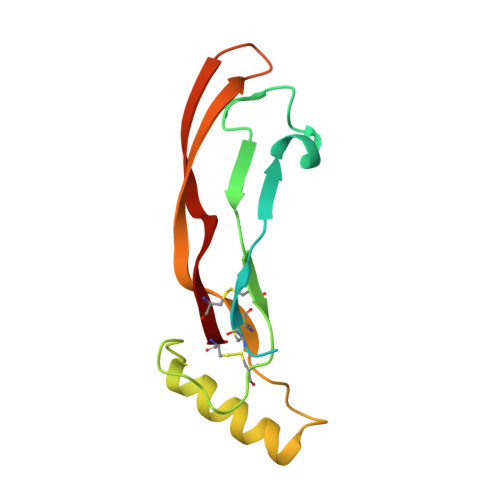BMP-3 and BMP-6 Structures Illuminate the Nature of Binding Specificity with Receptors.
Allendorph, G.P., Isaacs, M.J., Kawakami, Y., Belmonte, J.C., Choe, S.(2007) Biochemistry 46: 12238-12247
- PubMed: 17924656
- DOI: https://doi.org/10.1021/bi700907k
- Primary Citation of Related Structures:
2QCQ, 2QCW - PubMed Abstract:
Bone morphogenetic proteins (BMPs) are extracellular messenger ligands involved in controlling a wide array of developmental and intercellular signaling processes. To initiate their specific intracellular signaling pathways, the ligands recognize and bind two structurally related serine/threonine kinase receptors, termed type I and type II, on the cell surface. Here, we present the crystal structures of BMP-3 and BMP-6, of which BMP-3 has remained poorly understood with respect to its receptor identity, affinity, and specificity. Using surface plasmon resonance (BIAcore) we show that BMP-3 binds Activin Receptor type II (ActRII) with Kd approximately 1.8 microM but ActRIIb with 30-fold higher affinity at Kd approximately 53 nM. This low affinity for ActRII may involve Ser-28 and Asp-33 of BMP-3, which are found only in BMP-3's type II receptor-binding interfaces. Point mutations of either residue to alanine results in up to 20-fold higher affinity to either receptor. We further demonstrate by Smad-based whole cell luciferase assays that the increased affinity of BMP-3S28A to ActRII enables the ligand's signaling ability to a level comparable to that of BMP-6. Focusing on BMP-3's preference for ActRIIb, we find that Lys-76 of ActRII and the structurally equivalent Glu-76 of ActRIIb are distinct between the two receptors. We demonstrate that ActRIIbE76K and ActRII bind BMP-3 with similar affinity, indicating BMP-3 receptor specificity is controlled by the interaction of Lys-30 of BMP-3 with Glu-76 of ActRIIb. These studies illustrate how a single amino acid can regulate the specificity of ligand-receptor binding and potentially alter biological signaling and function in vivo.
Organizational Affiliation:
Structural Biology Laboratory and Gene Expression Laboratory, Salk Institute for Biology Studies, 10010 North Torrey Pines Road, La Jolla, California 92037, USA.














